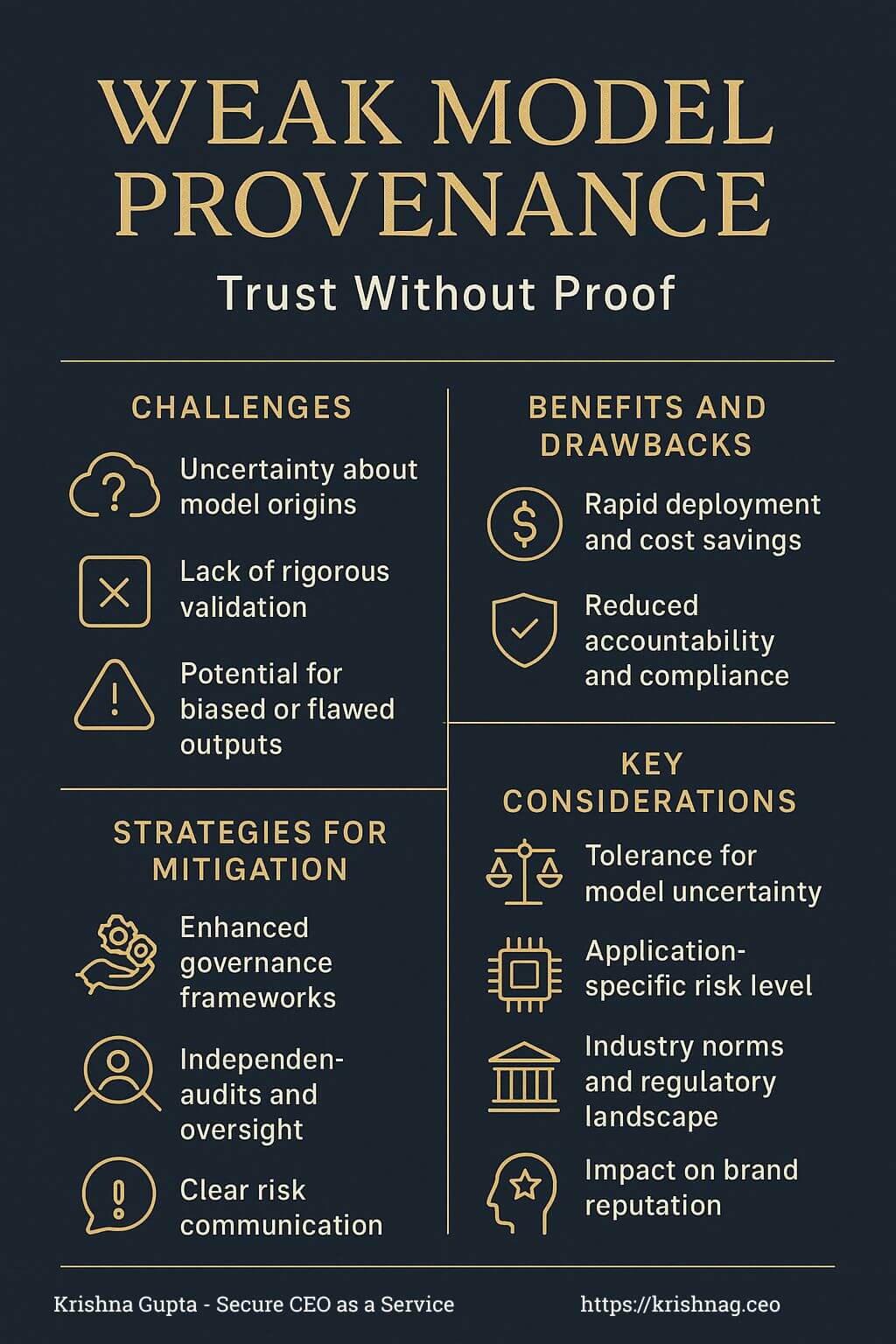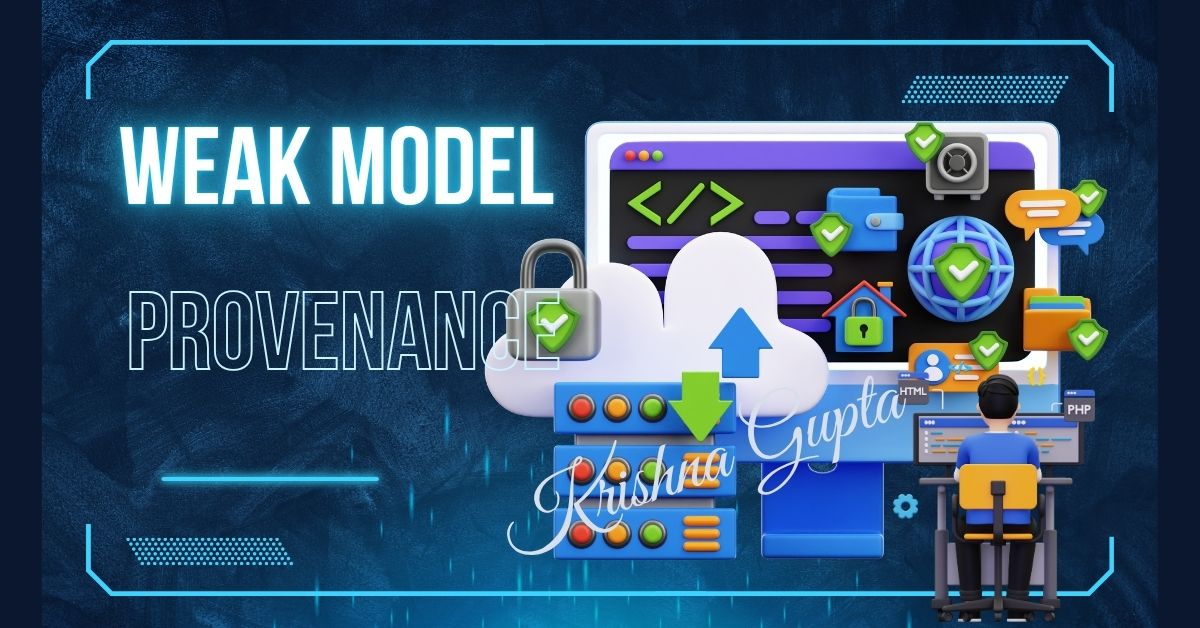Weak Model Provenance: Trust Without Proof
A critical weakness in today’s AI model landscape is the lack of strong provenance mechanisms. While tools like Model Cards and accompanying documentation attempt to offer insight into a model’s architecture, training data, and intended use cases, they fall short of providing cryptographic or verifiable proof of the model’s origin or integrity.
In essence, we’re placing significant trust in what is often self-attested metadata.
OWASP LLM-03: Supply Chain Vulnerabilities Explained
OWASP’s Top 10 for LLM Applications identifies LLM-03: Supply Chain Vulnerabilities as a critical risk area. It includes:
- Use of untrusted pre-trained models
- Insecure hosting environments
- Inadequate validation of model provenance
Just as we conduct security assessments for third-party software vendors, AI models require the same scrutiny.
The Problem with Current Model Documentation
- Model Cards are helpful but not authoritative. They provide context, not authenticity.
- Documentation is often created by the same entity that publishes the model, making it vulnerable to fabrication.
- There is no standardised chain-of-custody mechanism to validate a model’s journey from training to deployment.
Supply Chain Attacks via Model Repositories
A particularly insidious risk arises when attackers target model repositories. Here’s how it can play out:
- An attacker compromises the account of a legitimate supplier on a public model hosting platform (e.g. Hugging Face, GitHub).
- The attacker uploads a modified or backdoored version of a trusted model.
- Developers, assuming provenance based on the model’s name or metadata, download and deploy the tampered version.
- Social engineering techniques (such as impersonated emails or cloned websites) are used to add a layer of legitimacy.
This form of supply chain compromise mirrors classic software supply chain attacks like the SolarWinds hack, but with the added complexity of AI models being far less auditable and their behaviour inherently probabilistic.
Lack of Digital Signatures or Hash Validation
Surprisingly, many model repositories do not enforce digital signing or hash verification for uploaded models. Without a way to verify the authenticity of the model binary or weights:
- Tampered models cannot be easily distinguished from legitimate ones.
- Security-conscious developers are forced to build their own verification workflows, which may be inconsistent or incomplete.
Strengthening Model Provenance
To mitigate this systemic vulnerability, the following measures should be considered essential:
- Mandatory cryptographic signing of all models, verified by the repository platform.
- Immutable logs for model uploads and edits.
- Decentralised provenance tools using blockchain or distributed ledger technologies.
- AI-specific SBOMs (Software Bill of Materials), listing datasets, dependencies, and known contributors.
| Recommendation | Description |
| Cryptographic Signing | All models should be digitally signed and verified upon download. |
| Immutable Audit Logs | Every model upload/edit must be logged and immutable. |
| Decentralised Provenance | Use blockchain or distributed ledger technologies for traceability. |
| AI-Specific SBOMs | Generate Software Bills of Materials listing datasets, contributors, and versioning. |
Without secure provenance, every model integrated into your business is a potential Trojan Horse. And in high-stakes environments—like fintech, defence, or healthcare—the cost of such an oversight could be catastrophic.
Trust in AI must not be based on reputation alone. It must be verifiable, enforceable, and provable.
💼 Business Takeaway
Every unverified model is a potential Trojan Horse.
In high-stakes domains such as finance, defence, or medicine, the absence of provenance guarantees can lead to catastrophic outcomes. Security and compliance leaders must demand verifiable trust, not just descriptive trust, when sourcing and deploying AI assets.
AI trust is not inherited—it must be engineered.
Weak Model Provenance: Trust Without Proof
In the accelerating world of Artificial Intelligence (AI), models are becoming the core of decision-making in enterprises. These models determine creditworthiness, drive supply chain efficiencies, influence medical diagnoses, and underpin national security mechanisms. Yet, the provenance—the detailed record of origin, lineage, and development—of many AI models remains either weakly documented or entirely opaque. For the C-Suite, especially in sectors governed by compliance, fiduciary responsibility, and ethical mandates, relying on models with weak provenance is akin to trusting a financial audit report signed in invisible ink.
This blog post unpacks the business risks and strategic implications of deploying AI models with weak provenance. It is an urgent wake-up call for executives who understand that trust without proof is not trust, but a liability.
1. What Is Model Provenance?
Model provenance refers to the traceable documentation of how an AI model was created, trained, validated, modified, and deployed. It includes:
- Source of Data: Where the training data originated, its quality, representativeness, and compliance with privacy laws.
- Algorithmic Decisions: Choices made in model architecture, feature selection, and parameter tuning.
- Training Context: Environment in which the model was trained, including software versions, hardware, and random seed settings.
- Change History: Updates, retraining events, and post-deployment interventions.
Think of provenance as a ‘model passport’ or digital paper trail. In weak provenance scenarios, these details are incomplete, unverifiable, or entirely missing.
2. Why Should the C-Suite Care?
Executives are custodians of business integrity, not merely operations. Weak model provenance touches on multiple pillars of governance and risk management:
- Reputational Risk: A biased or poorly trained model can create discriminatory outcomes, damaging public trust.
- Regulatory Compliance: GDPR, HIPAA, and the upcoming EU AI Act demand explainability and accountability in AI systems.
- Operational Risk: Without provenance, diagnosing failure becomes guesswork. Recovery is slow and costs escalate.
- Cybersecurity Threat: Backdoored or tampered models without secure provenance can act as digital trojans.
ROI Implication: Investing in models with verified provenance ensures consistent and explainable performance, significantly improving operational resilience and reducing post-deployment costs.
3. Case Studies: When Provenance Fails
a. COMPAS Algorithm (United States)
The algorithm used in US courtrooms to predict criminal recidivism came under fire for racial bias. The model’s inner workings and training data were not transparent, resulting in a loss of judicial credibility.
b. Medical AI in the UK NHS
A diagnostic model for skin cancer trained largely on Caucasian datasets underperformed on patients of colour. The training provenance lacked demographic diversity documentation, leading to dangerous misdiagnoses.
c. Financial Services AI
A leading fintech firm faced a class-action lawsuit after its lending algorithm, procured from a third party, was found to offer higher interest rates to ethnic minorities. There was no provenance trail for how the model had been trained or tested.
Takeaway: Lack of provenance is not merely a technical oversight—it can become a brand-destroying crisis.
4. The Hidden Costs of Weak Provenance
| Cost Centre | Impact | Business Risk |
| Legal & Compliance | Fines, sanctions, audit failures | High |
| Operations | Extended downtime, poor scalability | Medium |
| Security | Increased vulnerability to model attacks | High |
| Human Resources | Reduced morale due to unexplained decisions | Medium |
| Customer Retention | Loss of trust and loyalty | High |
Tip: Weak provenance is a silent cost-driver. Enterprises must budget for the hidden cost of uncertainty.
5. Provenance as a Strategic Asset
Just as supply chain traceability became a standard post-COVID-19, model provenance must now be viewed as a core pillar of responsible AI. For the C-Suite, it represents:
- Audit Readiness: Enabling verifiable logs for both internal and external stakeholders.
- M&A Due Diligence: Assessing the value and liabilities of AI models during mergers.
- Brand Equity: Positioning the company as an ethical AI leader.
- Innovation Catalyst: Provenance enables repeatable and scalable innovation.
ROI Realisation: Transparency builds investor confidence and can even accelerate valuation in AI-heavy portfolios.
6. Technologies and Frameworks That Strengthen Provenance
a. ML Metadata Management Tools
- MLflow (Databricks): Offers experiment tracking and model registry.
- Weights & Biases: Tracks model training and hyperparameters with visual dashboards.
b. Blockchain for AI Provenance
- Immutable logs to track model changes and training history.
- Smart contracts to verify model authenticity.
c. Model Cards (by Google)
- A structured template to document the model’s purpose, performance, and limitations.
d. AI Governance Platforms
- IBM Watson OpenScale and Microsoft Azure ML integrate provenance tracking with bias detection and compliance features.
Insight: Tools exist, but organisational discipline in usage is key. Executive support and policy enforcement amplify their value.
7. Building a Culture of Provenance-First AI
Executives must lead from the front to institutionalise provenance practices.
Action Plan:
- Governance Charter: Mandate model provenance in AI project approvals.
- Training & Awareness: Equip cross-functional teams with the knowledge to document and audit model pipelines.
- Policy Enforcement: Implement SLAs and compliance checks for internal and third-party models.
- Vendor Vetting: Demand provenance logs as part of AI procurement due diligence.
- Third-Party Audits: Engage independent auditors to verify the provenance claims.
Pro Tip: Appoint a Chief AI Governance Officer (CAGO) to oversee model integrity and compliance.
8. Future of Provenance: Autonomous and Explainable
Emerging trends are reshaping how provenance is recorded and utilised:
- Self-Describing Models: Using agentic AI to automatically annotate their own training and operational history.
- Explainable AI (XAI): Models that not only perform but also justify their actions.
- Federated Learning: Adds complexity, but also the potential for decentralised provenance models.
- RegTech Integration: AI provenance checks automated within enterprise GRC (Governance, Risk, and Compliance) systems.

Executive Outlook: Treat provenance not as an afterthought but as an enabler of AI maturity and ethical leadership.
9. Practical Recommendations for the C-Suite
| Priority | Recommendation | Timeline |
| Immediate | Conduct a model provenance audit | 0-3 months |
| Short-Term | Update procurement checklists | 3-6 months |
| Mid-Term | Integrate provenance tools in ML pipelines | 6-12 months |
| Long-Term | Establish AI Governance Board | 12-18 months |
Checklist for AI Strategy Reviews:
- [ ] Does every model have a documented lineage?
- [ ] Can we trace the source of the training data?
- [ ] Are model updates and retrainings version-controlled?
- [ ] Are third-party models accompanied by provenance logs?
Final Insights
Trust in AI must be earned and continually proven. In a world where decisions by AI can impact millions of lives and billions in revenue, provenance is not optional; it is foundational. For the C-Suite, the message is clear: without model provenance, you are managing risk with a blindfold on.
Provenance is the bridge between technical excellence and strategic assurance. It is the evidence behind every claim, the insurance against AI drift, and the differentiator in a crowded market. As stewards of innovation and accountability, executives must prioritise model provenance as a critical enabler of trust, compliance, and sustainable ROI.

The future belongs to organisations that can not only build powerful models but also prove how and why those models can be trusted.